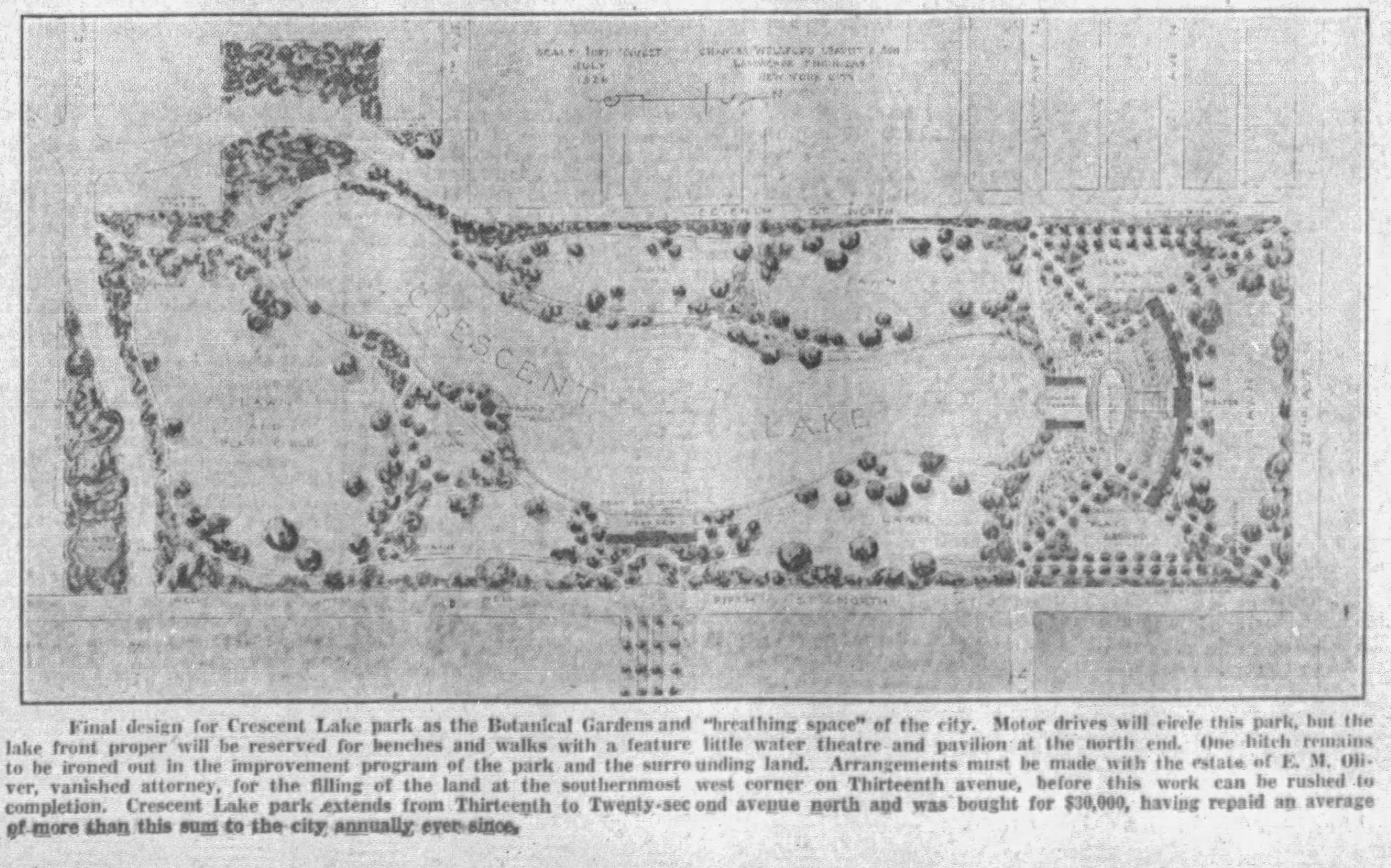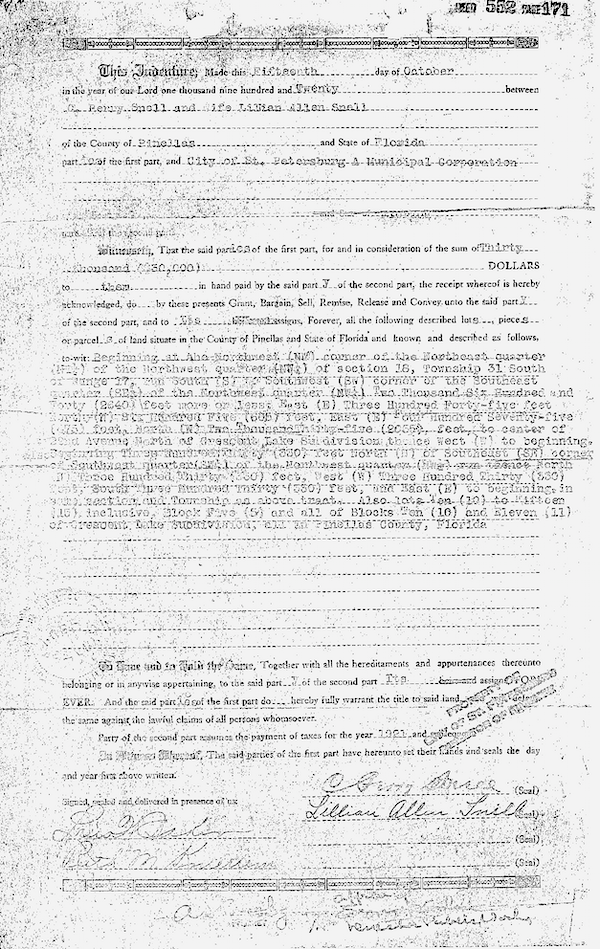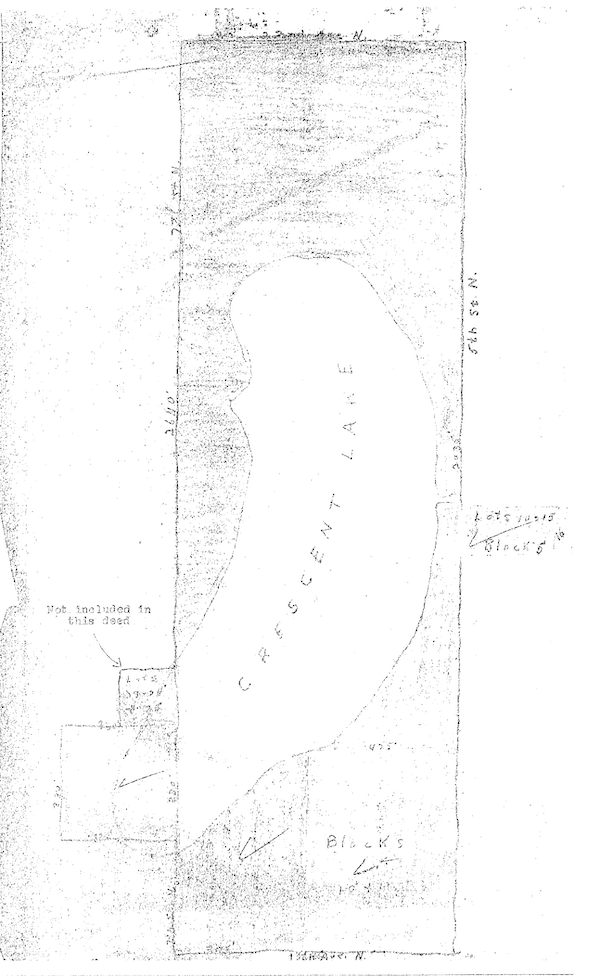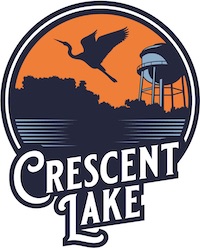Charles W. Levitt & Son’s 1926 plans for Crescent Lake Park. “Three Men Plan Parks of City.” St. Petersburg Times. 9 January 1927.

In the early 1900’s, C. Perry Snell was the owner of Crescent Lake and the land surrounding it – approximately 48 acres. He envisioned turning the property into a city park. In 1919, Mr. Snell sold Crescent Lake and the surrounding land to the city of St. Petersburg to turn it into a public park for $30,000. He sold it on easy terms so that the city could use money from its budget for the purchase price. The $30,000 price for the property was much less than the property’s value at the time of sale.
There were some additional tracts of land purchased by the City to establish Crescent Lake Park for a total of approximately 52 acres of property including the 18 acres of Crescent Lake. In 1927, the St. Petersburg Times estimated Crescent Lake Park’s value at $1,000,000. Mr. Snell’s vision and generosity left its mark on our great city by ensuring the preservation to public uses of Crescent Lake Park. If it were not for Mr. Snell’s vision, Crescent Lake Park and St. Petersburg’s waterfront would have most likely been developed.
In 1920, the city began its plans for a Crescent Lake athletic field for “Big League Training.” The nearest car line to the park was on Ninth Street N (MLK Jr. St. N). The plans were to build a car line directly to the park once established. The park board also indicated its desire to build a botanical garden in the park, including tropical water plants in the lake. The city nursery would be moved in to Crescent Lake Park that winter and the city would supervise the work of planting the seeds, which would be the future shade trees for St. Petersburg. At that time, the park board ordered a large supply of pepper seeds from California to be planted in the Crescent Lake nursery, which would be used to provide shade for the city’s waterfront park. The heavy undergrowth of palm trees and tropical shrubbery would be thinned out and shrubs would then be transplanted to the waterfront for shade. By the next year, the park board estimated they would have 5,000 shade trees ready to transplant in the city’s waterfront park.
In 1921, some of the work done at Crescent Lake Park included planting 2,000 palm seed: Cocoa-nut plumosas, Washingtonians, and Phoenix, hoeing and weeding all shrubbery in nursery, making 475 oleander cuttings, digging 187 yards of ditch, three feet wide and 2 feet deep thereby lowering Crescent Lake itself 18 inches, and cleaning 561 feet by 120 feet from Fourth street to the lake to allow for a view of the lake. So much work was being accomplished in Crescent Lake Park that in July 1922 the St. Petersburg Times reported that “[i]f you don’t go soon there won’t be any swamp there, and it would take a Daniel Websterian pummeling to make you believe that there had ever been a swamp where crescent park was created.” If you went to Crescent Lake Park you would then be able to “tell the tourists what you saw out there before beautiful Crescent Lake park was planted and landscaped and garmented in loveliness.”
In 1923, there were reports of wild monkeys seen near Crescent Lake. A young ring-tailed monkey was captured and residents near the lake reported seeing several monkeys playing in the trees north of the lake. It was reported that these monkeys were offsprings of a pair of small monkeys a local contractor had released into the “jungle” known known as Crescent Lake Park. So, not only was Crescent Lake a refuge for ducks and alligators, but monkeys too.
The task of beautifying the park began in 1925. In 1926, the City contracted Charles W. Leavitt and Son, landscape architects of New York, to draw up skeleton plans for Crescent Lake Park. By September 1926, Crescent Lake had been completely cleaned of the growth of water hyacinths covering it. A municipal dredge had removed approximately 216,000 cubic yards of sand in filling the low ground around the lake shore at a cost of about $67,500. Through Leavitt’s plan the lake was “transformed from a hyacinth covered mass of water and jungle, into an attractive park.” (St. Petersburg Times, 14 October 1928) Although the ambition of the Park board Chairman W.F. Smith was to develop Crescent Lake Park along the general lines of the tropical gardens of Rio de Janeiro, lack of funds derailed those plans.
Bibliography:
“Athletic Field Will Be Located in Central Park.” St. Petersburg Times. 6 August 1920.
“Dedicate Entire West Side of Park to Pleasure Clubs.” St. Petersburg Times. 5 February 1921.
“Head of Parks Makes Report.” St. Petersburg Times. 8 October 1921.
“Sigma Chi’s Corner: Saving Swamps Society.” St. Petersburg Times. 7 July 1922.
“Wild Monkeys Seen Near Crescent Lake.” St. Petersburg Times. 22 July 1923.
Reed, Ralph. “New Park Formed at Crescent Lake.” St. Petersburg Times, 12 October 1924.
“City Receives Park Program.” St. Petersburg Times. 14 July 1926.
“5,000,000 is Voted in 1926.” St. Petersburg Times. 12 September 1926.
“City Park System Owes Its Growth to Snell’s Help.” St. Petersburg Times, 30 January 1927.
“City Beautifies, Expands Extensive System of Parks.” St. Petersburg Times. 14 October 1928.
Grismer, Karl H. The Story of St. Petersburg. P.K. Smith & Co., 1948.
Arsenault, Raymond. St. Petersburg and the Florida Dream 1888-1950. The Donning Company, 1988.

Warranty Deed from C. Perry Snell to the City of St. Petersburg

Warranty Deed from C. Perry Snell to the City of St. Petersburg

C. Perry Snell Property drawing

